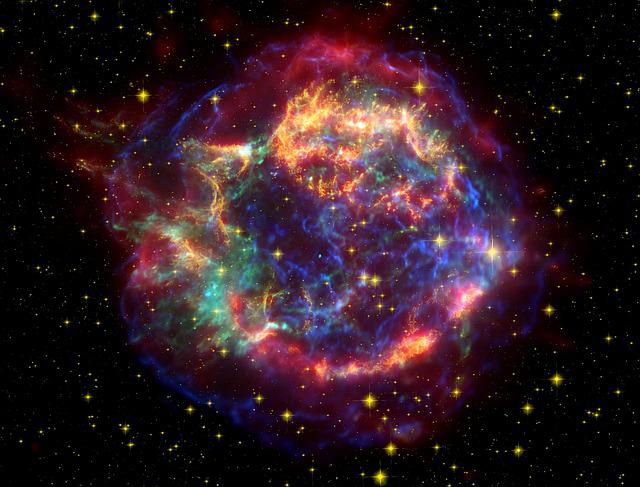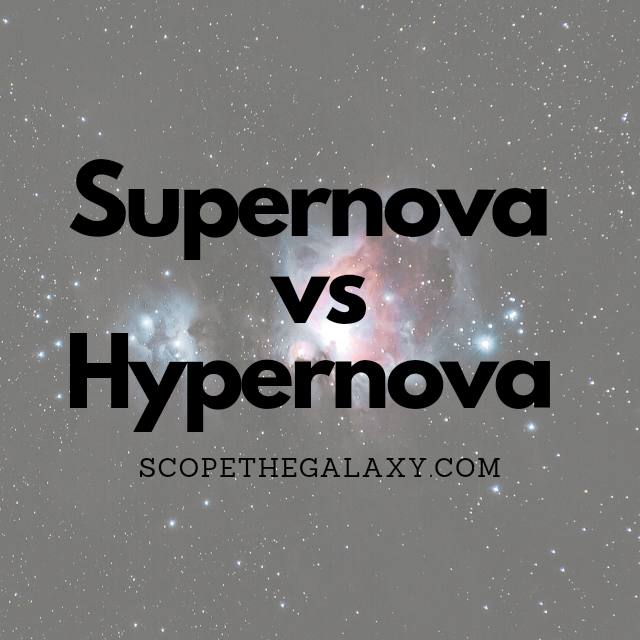*This post may contain affiliate links. This means we may make a commission if you purchase an item using one of our links*
Both hypernova and supernova explosions occur once nuclear fusion is unable to convert hydrogen into helium, forcing stars to collapse and produce these bright grandiose showcases.
The main difference between a supernova and hypernova is that hypernova’s tend to be 5 – 50 times more powerful, caused when a star 30+ solar masses explodes and produces light that is 10 – 100 times brighter than your average supernova.
That’s just the base difference between but, if you want a more detailed breakdown of the similarities and differences between these 2 stellar explosions, continue reading.
What Is A Supernova?
Table of Contents

Supernovae a classified under 2 different types where a type 1 supernova is an explosion that leaves no hydrogen line emissions in the spectra and a type 2 supernova is distinguished where a star 15 times the mass of our sun explodes and does produce hydrogen line emissions.
There are two ways that a supernova explosion can form.
It can either be via a white dwarf in a binary star system that accumulates too much energy from its companion star causing it to explode or when a larger star runs out of nuclear fuel and collapses under its own gravity, leaving behind the bright and grandiose remnants of this explosion many times brighter than even its own galaxy.
As stated above supernovae are generally split into 2 types, a type 1 supernova or a type 2. Type 1’s are then further split into 1 of 3 subcategories, Ia, Ib or Ic.
A type 1a supernova is the most commonly observed in outer space and acts like a candle light to help us observe distance across the deep unknown.
These are theorised to form after a white dwarf, likely in a binary star system, exploding due to the over consumption of energy from its companion. Type Ia’s have a strong silicon absorption line near its maximum luminosity whilst producing no hydrogen at the same time
Type Ib’s are formed after a large star collapses under its own core gravity where the outer region of the stars hydrogen is stripped away, leaving behind only second layer of helium that remains.
Type Ic’s lack both the hydrogen and helium layer when they explode, although the difference here has been debated as not being significant enough to differentiate a type Ib from a Ic.
Type 2 supernovae are formed when a star between 8 – 50 times the Sun’s mass collapses into itself and causes a huge explosion that produces a black hole in most cases. This is because black holes require the remains from a supernova to be atleast 3 solar masses.
In essence anything above 20 times the size of our Sun can potentially result in a black hole whilst a white dwarf star that is 1.44 solar masses or between 10 – 20 times the mass of our Sun would produce a neutron star instead.
What Is A Hypernova?

Hypernovae are supernova explosions but on steroids.
In essence your typical hypernova will produce explosions that are anywhere from 5 times to 50 times more powerful than a supernova explosion.
The typical hypernova will be formed after the death of star that is atleast 30 times the mass of our Sun, where they will generally have enough mass after the explosion to form a spinning black hole surrounded by an accretion disc and two stellar jets traveling close to it at the speed of light.
These explosion are much rarer than your typical supernova as they tend only to be observed 5 times over a million year period but, when they do happen, they’ll often produce light that is 10 – 100 times the brightness of a supernova.
Considering supernovae produce light that is often brighter than entire galaxies, a hypernova explosion would be blinding.
Not to mention extremely powerful where in the theory one explosion, that would typically have remnants sticking around a few months, would be able to power Earth for a billion, billion, billion years!
After the explosion has settled, only a black hole will remain. This is quite a juxtaposition as arguably the most luminous showcase produced in the universe tends to create celestial objects that allows no light to escape it.
Is A Hypernova Larger Than A Supernova?
A supernova only requires a white dwarf that is a minimum of 1.44 solar masses or a normal star that is 8 solar masses do occur, whilst hypernovae need a star 30 solar masses to collapse in order to form
Therefore, it only makes sense that a hypernova will be larger.
As stated above they will also be more powerful too, between 5 – 50 times the strength of an explosion that falls within the supernova range.
Similarities Between A Supernova And A Hypernova
Both are explosions that occur when a star is nearing the end of its lifespan, that are extremely luminous and are unable to convert hydrogen to helium through nuclear fusion.
Both are extremely grandiose and bright to the extent they will outshine entire galaxies whilst sticking around, at most for a few months. They aren’t extremely different in how they occur, but when it comes to size and power, they do differ significantly.
Differences Between A Supernova And A Hypernova
As for what the differences between a supernova and hypernova explosion are, they include the following:
- Hypernova explosions are between 5 and 50 times more powerful than a supernova
- Hypernovae are the byproduct of when a star that is 30+ solar masses in size collapses whilst a supernova can occur when a white dwarf that is 1.44 solar masses or a normal star that is 8 solar masses explodes.
- As hypernova’s are so big , they will always produce a black hole as the remnant of the dead star whilst supernova can form either a neutron star or black hole
- Hypernova explosions can be between 10 – 100 times brighter than a supernova.
- Hypernova explosions only occur once every 200,000 years whilst supernova are more common where they tend to occur once every 50 years.
Summary
In short, supernovae and hypernovae both happen under the same or very similar circumstances, where both will produce stellar remains, whether it be a neutron star or black hole.
Hypernova are simply a more powerful supernova, both in energy produced and luminosity. Therefore, it only makes sense that the more powerful one is far less common.

